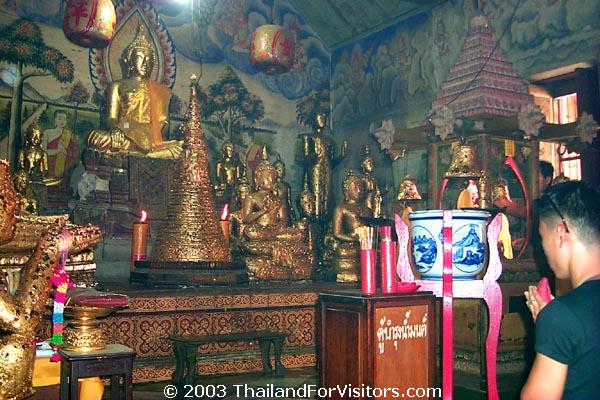Wat Phra Buddhabat

For a westerner, perhaps one of the more curious aspects of Buddhism is the tradition of Buddha footprints. Many temples will have reproductions of the feet of buddha, which are used to illustrate the 108 "auspicious signs" by which they can be recognized. One of the best examples of these is the feet of the reclining buddha found in the Bangkok temple commonly known as Wat Po.
But the curious part is the tradition that real footprints can be found in the countryside. This tradition holds that the buddha, or an incarnation known as "the future buddha" left these to guide us to enlightenment. Since most of these footprints are the size of a bath-tub, the future buddha apparently is not someone to mess with.
When found in nature, these relics are subjected to extreme scrutiny to insure they have all of the right signs, then they become places of worship. There are actually several buddha footprint temples in Thailand, but the most important of these is the Phra Puddhabat temple in Saraburi Province. It is under royal patronage of the first class.

Although it bit off the tourist track, the temple is the site of a pilgrimage fair in January/February and March. We visited the temple during the fair held in January of 2002.
The footprint is located on a rocky outcropping about 25 kilometers north of Saraburi town. The footprint itself is covered by an ornate, jewel-like building called a mondop. The outside walls are covered in blue and green mirrored tiles, and gold leaf. We can think of only one other place where you will see this kind of religous structure, and that is in the temple of the emerald buddha in Bangkok. That mondop is only open one day a year, on 6 April, and houses images of the kings of the Chakri dynasty.

You can pay your respects to the buddha footprint on any day, but if its a pilgrimage day be prepared for a crowd! Passing through the mother of pearl inlaid doors, the footprint occupies the center of the small building. The interior walls are red laquer with gold leaf. A canopy covered in gold and mirrors is built over the footprint.
Although the footprint was discovered around 1624 to 1628, the mondop and canopy date from the early 19th century. The originals were destroyed by brigands during the confusion that resulted from the sacking of Ayuthaya in the late 18th century. From the main entrance, you climb a long stairway up to the mondop. Don't worry, its a "grand entrance" of modest height, not a 300 step endurance test such as found at some Thai temples.

The mondop sits on a platform built over the rock ledge containing the footprint at the base of a hill, although rock outcroppings spring out of the platform in a few places. Shrines of various styles and sizes dot the platform as well as the outcroppings. Its a wonderfully organic temple complex that's like no other we've seen in Thailand. Be sure to allow plenty of time for exploring.

Behind the mondop, a series of platforms continues on up the hill, which is actually one of many limestone outcroppings dotting the countryside around Saraburi. Indeed, the main industry of Saraburi seems to be tearing down these mountains to harvest marble and lime for cement.
The large lower platforms contain wiharns of different styles. The last of these before the platforms turn into a path ascending the hill is worth a look. Inside this small chapel, the walls are painted in with watercolor-like scenes from the buddha's life. The alter contains buddha images posed for the seven days of the week. To the right is a small buddha in a sort of case with bells hung from the roof. Merit-makers ring each bell three times (and only three times, if you please).

If you have the stamina, the climb on up to the top of the hill is well worth it. You climb a winding stairway up through trees to reach another plateau near the crest of the stone hill. There's another wiharn here, and views down through the trees at the mondop and surrounding area.
From here, signs (in Thai only, we're afraid) lead you on a winding path around the very peak of the hill to the other side. Here are veiws across a valley to another peak, and another path which leads down and around the other side. At the end of this path is a modest entryway to a small cave. Actually, it looks less like a cave and more like a space common to this kind of geology, hollowed out by water and perhaps partially collapsed. There are many other smaller holes and cracks which let light into the chamber from almost all directions, giving the interior a sort of suffuse glow with few shadows.

The cave contains a seated buddha image on a raised dais. The signs pointing the way to the cave had lead us to expect a reclining buddha. I overheard some Thais ask the attendant about this, and apparently the name is meant to imply "buddha's bedroom" rather than a reclining buddha.
From the cave, you need to retrace your steps back up and around the top of the peak, then back down to the mondop. There's a small museum on the lower levels that may be a good place to cool off. There is also a well kept chinese meeting hall against the north wall of the temple complex.
Saraburi is about 140 kilometers north of Bangkok. Its a comfortable hour and a half drive on good roads, with a divided highway almost all the way there. The old royal town of Lopburi is just another 20 kilometers from Wat Phra Phuddhabat. The two sites would make a good day trip from Bangkok.
